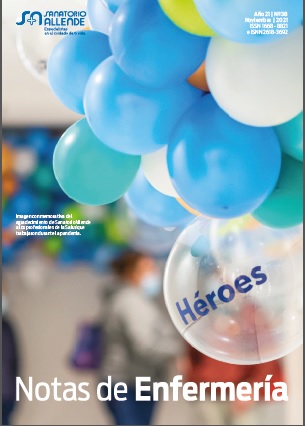Diabetic patient admission protocol. An approach from the basic conditioning factors and the self-care agency
DOI:
https://doi.org/10.59843/2618-3692.v21.n38.35409Keywords:
diabetes, basic conditioning factors, self-care agency capability, nursing, Dorothea OremAbstract
The International Nurses Council (INC – 2015) defines Nursery as the independent and accompanied care given to people of all
ages, ethnicity, gender, rather family, group and communities, ill or heathy in all sort of contexts. Including Heath`s promotion,
sickness prevention and different cares of patients, disable and dying people. In turn, Berbiglia and Banfield cite Orem, which
states that the practice Nursing practice as the relationship among individuals, which is institutionalized around the process
of one person the Nurse, the one who helps directly to the other person, when this one is not fully or partially capable on their own means to help themselves to take charge of their daily health care, caused by the actual health situation remaining. The same author defines the state of health that indicates the Nurses assistance as “The non-capacity of people to assure by themselves the continued self-care, nor in quality and quantity necessary according to the situation of personal health”. On the other hand, the author, also states that the basic conditioning factors are "internal or external factors handled by individuals who affect their abilities to engage in self-care or affect the type and amount of self-care required ". The objective is to systematize and agree on interventions and nursing care in the admission of the patient with diabetes, with an approach from the basic conditioning factors of self-care and the capacity of the Self-care agency, who enter the emergency department of adults, of a public hospital, 2020 In this sense, the nursing professional plays a fundamental role within the health team to identify the deficit of self-care and promote, manage and promote various strategies for health promotion, disease prevention and treatment.
Downloads
References
1 Organización mundial de la salud (OMS). “Diabetes”. [Internet]. 2015. [consultado marzo 2020]. Disponible
en: http://www.who.int/mediacentre/factsheets/fs312/es/
2 Orem D. E. “Modelo de Orem. Conceptos de enfermería en la práctica”. Barcelona- España. Ed. Ediciones
Científicas y Técnicas. S.A. 1993.
3 Bergiglia, V. & Banfield, B. “Dorothea E. Orem. Teoría del déficit de Autocuidado”. En Alligood, M. y Marriner,
A. Modelos y Teorías en Enfermería. 2011. Séptima Edición. Elsevier. España.
4 Op. Cit. Orem D. E. “Modelo de Orem. Conceptos de enfermería en la práctica”.
5 Fawcett J. “Contemporary Nursing Knowledge. Analysis and Evaluation of Nursing Models and Theories”.
Second Edition. F.A. Davis Company. Philadelphia. 2006. USA. Versión digital.
6 Op Cit. Bergiglia, V. & Banfield, B. “Dorothea E. Orem. Teoría del déficit de Autocuidado”.
7 Federación Internacional de Diabetes. “Que es la diabetes- Complicaciones de la diabetes”. [Internet]. 2017.
[Consultado marzo 2020]. Disponible en: https://www.idf.org/about-diabetes/what-is-diabetes.html#content_
7 8 Op. Cit. Organización mundial de la salud (OMS). “Diabetes”.
9 Federación Argentina de Diabetes. “Diabetes San Luis”. [Internet]. 2017. [Consultado marzo 2020]. Disponible
en: https://www.argentinadiabetes.org/diabetes-en-san-luis/
10 Roses M. & Rosas Guzmán J. (2009). “Clasificación de diabetes mellitus”. [Internet]. 2009. En Organización
Panamericana de Salud. Guías ALAD de diagnóstico, control y tratamiento de la diabetes mellitus tipo
II. Capítulo 2. [Consultado marzo 2020]. Disponible en: http://www1.paho.org/hq/dmdocuments/2010/
Guias_ALAD_2009.pdf
11 Organización mundial de la salud (OMS). “Diabetes”. [Internet]. 2020. [consultado marzo 2020] Disponible
en: https://www.who.int/topics/diabetes_mellitus/es/
12 Del Olmo González, E.; Carrillo Pérez, M. y Aguilera Gumpert, S.,(2008). “Actualización del tratamiento
farmacológico de la diabetes mellitus tipo 2”. [Internet]. 2008. Vol. 32:1. [Consultado abril 2020]. Disponible
en: http://www.msssi.gob.es/biblioPublic/publicaciones/docs/vol32_1ActuaTratDiabetesMellitus.pdf
13 Op. Cit. Federación Argentina de Diabetes. “Diabetes San Luis”.
14 Op. Cit. Fawcett J. “Contemporary Nursing Knowledge. Analysis and Evaluation of Nursing Models and
Theories”.
15 Ibidem. Fawcett J. “Contemporary Nursing Knowledge. Analysis and Evaluation of Nursing Models and
Theories”.
16 Op. Cit. Orem D. E. “Modelo de Orem. Conceptos de enfermería en la práctica”.
Downloads
Published
Issue
Section
License
Copyright (c) 2021 Sanatorio Allende

This work is licensed under a Creative Commons Attribution-NonCommercial 4.0 International License.
Those authors who have published with this journal, accept the following terms:
- Attribution — You must give appropriate credit, provide a link to the license, and indicate if changes were made. You may do so in any reasonable manner, but not in any way that suggests the licensor endorses you or your use.
- NonCommercial — You may not use the material for commercial purposes.

